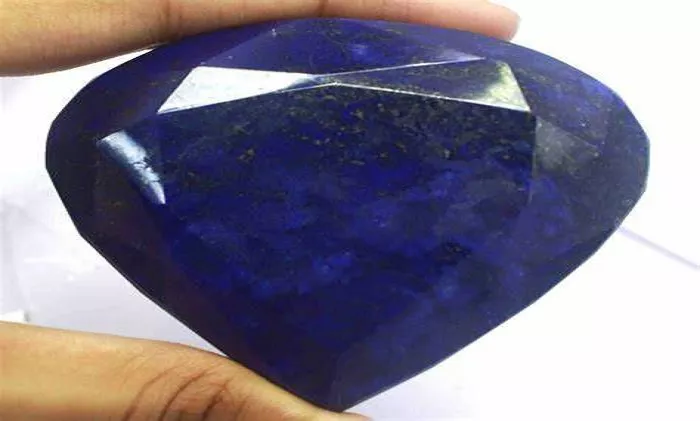Natural dark blue sapphire is one of the most sought-after gemstones in the world. Its deep, rich color captures attention and exudes elegance. Sapphires belong to the corundum family, which also includes rubies. What makes sapphires special is their remarkable hardness, second only to diamonds. This durability makes them perfect for everyday wear in rings, necklaces, and other jewelry pieces. Among sapphires, the dark blue variety stands out for its intense and mesmerizing hue.
The Color and Composition of Dark Blue Sapphires
The color of a natural dark blue sapphire can range from a velvety midnight blue to a deep ocean shade. The finest specimens display a vivid saturation without being too dark or inky. The presence of iron and titanium within the crystal structure gives the stone its signature blue tone. Trace elements influence the exact shade, making each sapphire unique. Some dark blue sapphires may also exhibit a slight violet undertone, adding to their complexity.
The Most Prized Sapphire Origins
One of the most important factors in evaluating a dark blue sapphire is its origin. Sapphires from Kashmir, Burma, and Ceylon (Sri Lanka) are highly prized. Kashmir sapphires, though rare, are renowned for their cornflower blue hue with a velvety appearance. Burmese sapphires often have a rich, royal blue color. Ceylon sapphires tend to be lighter but can also produce exceptional dark blue stones. Madagascar has also become a significant source of fine dark blue sapphires in recent years.
The Importance of Cut and Clarity
The cut of a sapphire greatly affects its beauty. A well-cut stone will reflect light evenly, enhancing its brilliance and color. Dark blue sapphires are often cut into ovals, cushions, or emerald shapes to maximize their depth. Since darker stones can appear too dense, skilled cutters may use shallower angles to allow more light to pass through. Clarity is another important consideration. Natural sapphires often contain inclusions, which are tiny imperfections formed during their growth. While flawless sapphires are extremely rare, some inclusions can actually prove the stone’s natural origin.
Treatments and Enhancements in Sapphires
Treatment is a common topic in the sapphire trade. Most natural sapphires undergo heat treatment to improve their color and clarity. This process is widely accepted in the industry as long as it is disclosed. Untreated dark blue sapphires are rare and command much higher prices. Other treatments, such as diffusion or fracture filling, are less desirable and should always be disclosed to buyers. When purchasing a dark blue sapphire, it is important to ask about any treatments it may have undergone.
The Historical and Symbolic Significance of Sapphires
Dark blue sapphires have been cherished throughout history. Ancient civilizations believed sapphires symbolized wisdom, nobility, and divine favor. Kings and clergy wore them as talismans for protection. In modern times, sapphires remain a symbol of luxury and romance. The most famous example is the engagement ring worn by Princess Diana, now passed down to Kate Middleton, featuring a stunning blue sapphire surrounded by diamonds.
How to Choose the Perfect Dark Blue Sapphire
When buying a dark blue sapphire, it is essential to examine it under different lighting conditions. Natural light, fluorescent light, and incandescent light can all reveal different aspects of the stone’s color. A high-quality sapphire will maintain its beauty in various lighting environments. It should not appear too black in dim light or washed out in bright light.
Jewelry Settings That Enhance Dark Blue Sapphires
The setting of a dark blue sapphire can enhance its appeal. White gold or platinum settings complement the stone’s cool tones, while yellow gold creates a striking contrast. Halo designs, where the sapphire is encircled by smaller diamonds, add extra brilliance. For a more modern look, a solitaire setting allows the sapphire to stand alone as the focal point.
Caring for Your Dark Blue Sapphire Jewelry
Caring for a dark blue sapphire is simple due to its hardness. Regular cleaning with mild soap and warm water will keep it looking its best. Ultrasonic cleaners are generally safe unless the stone has significant inclusions or fractures. Storing sapphire jewelry separately from other gems prevents scratches, even though sapphires are highly resistant to damage.
Investing in a Natural Dark Blue Sapphire
Investing in a natural dark blue sapphire can be a wise decision. High-quality sapphires from reputable sources tend to hold their value well over time. Rarity, color, and origin all play a role in determining a sapphire’s worth. Collectors and jewelry enthusiasts often seek out exceptional pieces, making dark blue sapphires a timeless choice.
Conclusion
In conclusion, natural dark blue sapphires are among the most captivating gemstones available. Their deep color, durability, and historical significance make them a favorite for fine jewelry. Whether set in an engagement ring, pendant, or pair of earrings, a dark blue sapphire adds a touch of sophistication and elegance. Understanding its characteristics, origin, and care ensures that you select a stone of exceptional quality—one that will be treasured for generations.
Related Topics:
- Can You Combine Blue Sapphire and Ruby in Jewelry?
- Where is Sapphire Blue Hole?
- Is Sapphire Scratch-Resistant? Everything You Need to Know


